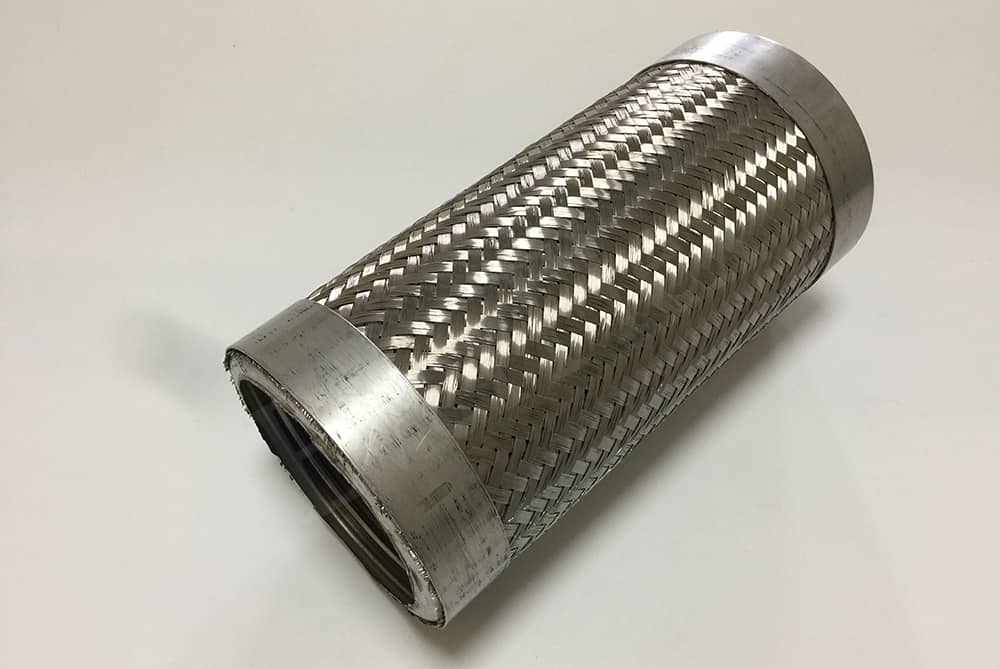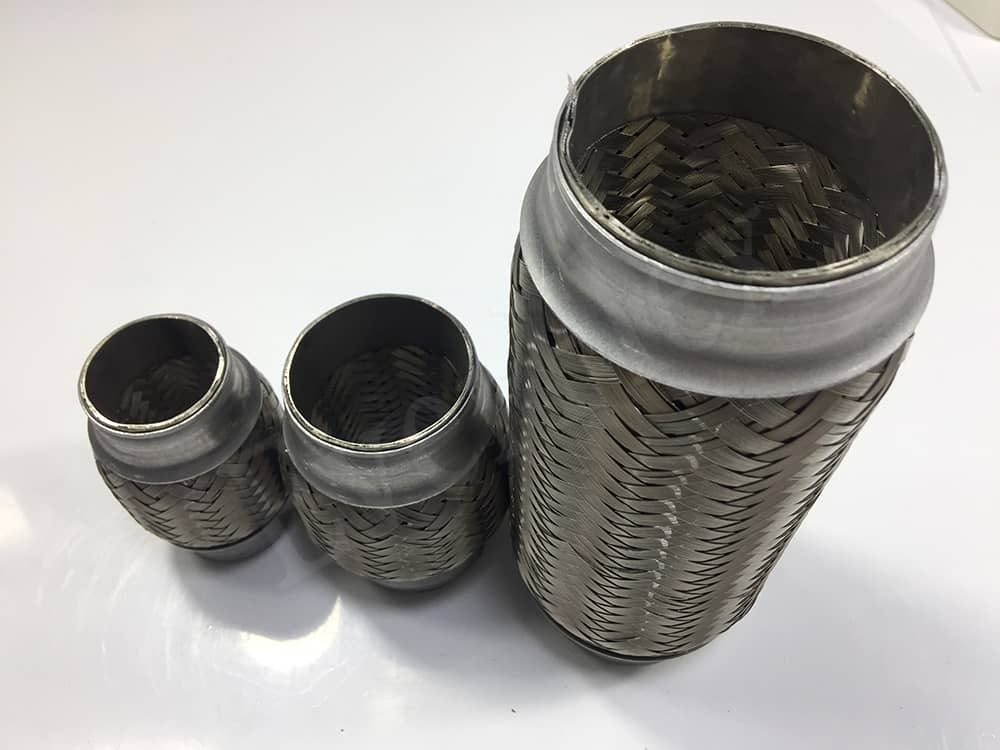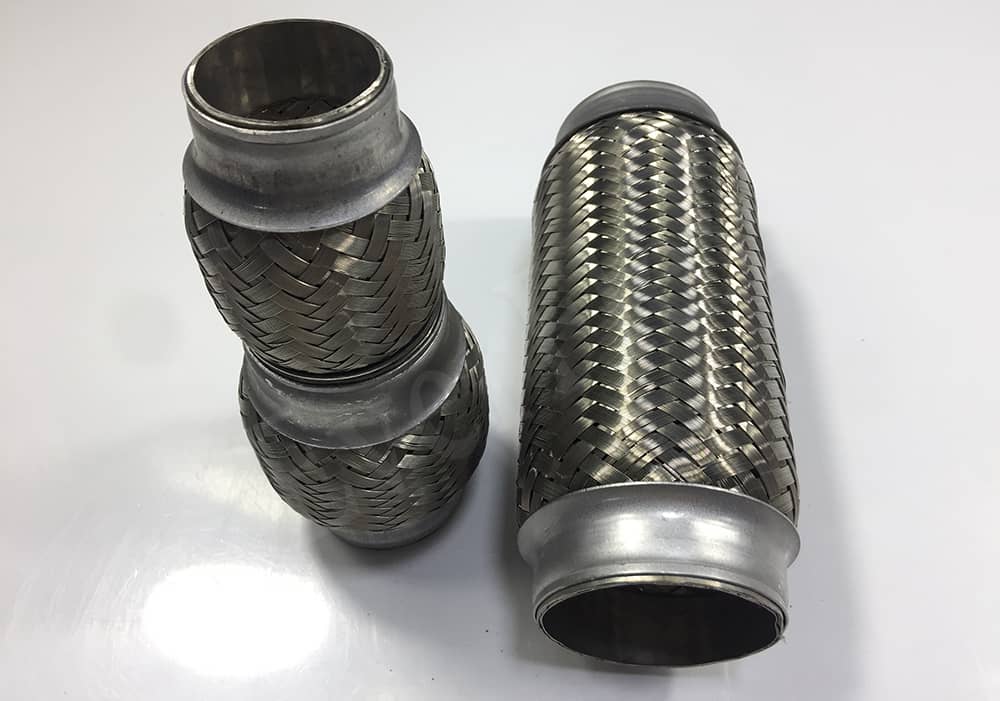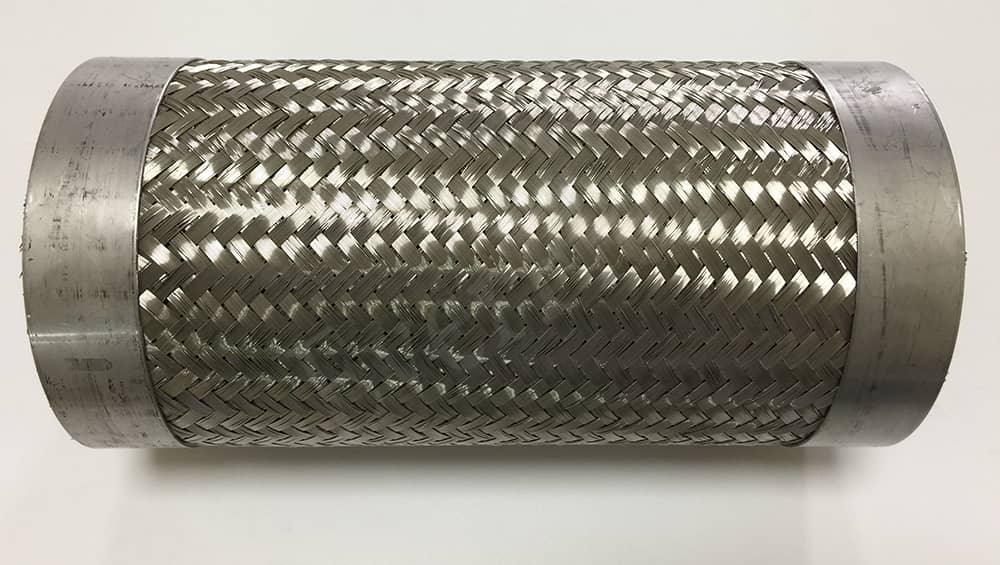Metal hose is a high-quality flexible pipe in modern industrial pipelines. It is mainly composed of bellows, mesh sleeves and joints. Its inner tube is a thin-walled stainless steel bellows with spiral or annular waveforms. The mesh sleeve on the outer layer of the bellows is woven from stainless steel wire or steel belt according to certain parameters. The joints or flanges at both ends of the hose are matched with the joints or flanges of the pipeline. The mesh sleeve is the main pressure-bearing part of the hose installed in the pressure pipeline. At the same time, it acts as a sheath for the bellows. According to the pressure in the pipeline and the application site, one or more layers of stainless steel wire or steel belt can be selected for weaving
The material used to make the main parts of the hose is stainless steel. Therefore, the excellent temperature resistance and corrosion resistance of the hose are guaranteed. The working temperature range of the hose is extremely wide, from -196 to 600 ℃. The hose used can be selected according to the corrosiveness of the medium passing through the pipeline. The corrosion resistance of the hose can be guaranteed.
Scope of application of hose
The delivery pipe that requires full flexibility is used to prevent the piping in the vibration place. It is suitable for steam, gas, air, heavy oil, petroleum, chemical drugs, etc.
Application of metal hose
Metal hose pipes are widely used in automatic control and measuring instruments, vacuum technology, machinery industry, power industry, transportation and atomic energy industry as sensitive elements, shock absorbing elements, compensation elements, sealing elements, valve elements and pipeline connectors.
Metal bellows choose different metal materials for different uses. Due to different materials, the performance and use of the processed metal bellows are also different.
Pipe blank matching
The metal hose pipe blank is made of thin-walled stainless steel strip welded pipe with corrugated processing, which is flexible and has good temperature and pressure resistance. It is suitable for the transportation of various fluid media such as air, steam, various industrial gases, water, oil, and drugs, and plays an important role in the reciprocating motion of the pipe system, the absorption of thermal expansion system, the absorption of vibration, and the center adjustment of the piping.
Summary of metal hose names
Metal hoses are also called stainless steel metal hoses, braided metal hoses, etc.
The structure of flanged metal hose
The stainless steel corrugated pipe is braided with one or more layers of steel wire or steel belt mesh sleeves, and the two ends are equipped with joints or flange heads. It is a flexible element for conveying various media. The function of this product is to install a flexible pressure-resistant pipe fitting in the liquid conveying system. It is used to compensate for the mutual displacement of the connection ends of pipelines, machines and equipment, absorb vibration energy, and can play a role in vibration reduction and noise reduction.
What is the normal applicable medium temperature of metal hoses?
The moisture in the air source is filtered in the metal hose. Because the air source is not pure gas, the air source sent by the metal hose generally has moisture. Therefore, the use of metal hoses ensures that there will not be a lot of moisture in the cylinder. The air source of the air compressor is usually 8kg. The air source pressure received by the hose is generally between 4-7kg. The metal hose can reduce the pressure to 4-7kg. Generally, vertical lifting check valves should be used on horizontal pipes with a nominal diameter of 50mm. Check valves are generally suitable for clean media and should not be used for media containing solid particles and high viscosity.
Main function of metal hose pipe
Reduce internal stress
To put it simply, internal stress means that due to various reasons, the pipeline cannot be installed so properly in the working environment. Then there will be additional axial or angular forces, or stretching or shortening. This is too hard for ordinary steel pipes. If you can’t install it, you can’t install it, and the rubber tube is not durable. So the best way is to use stainless steel hoses. Its internal stress is very small under its bending radius, which is safe and convenient to install. So kill two birds with one stone.
Pipeline displacement
In many cases, stainless steel hoses are installed in places where there is frequent partial displacement or frequent movement. For example, in the filling tank of liquefied gas and hydraulic mechanical equipment, there will be corresponding vibrations as the machinery operates. These places must not only be corrosion-resistant, pressure-resistant, but also shock-resistant. So metal hoses are suitable.
Shock-absorbing effect
General hoses have a shock-absorbing effect, and stainless steel hoses are no exception. It can not only improve the system’s ability to fatigue damage, but also reduce noise. Especially in coal mines and chemical industries. So the use of metal hoses is very appropriate.
What are the factors that affect the purchase of metal hoses?
Metal hose pound grade outer diameter, selected connection head mode (mainly flange connection, pipe thread connection, quick connection head connection) and metal hose level, plastic pipe length.
Pressure
According to the actual pressure of the metal hose, then check the corrugated metal hose pressure gauge to decide whether to use a metal hose of the stainless steel mesh sleeve type.
Chemical substances
The chemical properties of the substances commonly transported in the metal hose. According to the corrosion resistance of the plastic pipe material, the material of each part of the plastic pipe.
Temperature
The working temperature and enterprise scale of the substance in the metal hose; the operating temperature of the plastic pipe during operation. At high temperature, the working pressure temperature of the metal hose at high temperature must be checked. Determine the pressure after temperature inspection to determine the correct pressure level.
Advantages of metal hose
As an important pipeline solution, metal hose has many advantages. It provides efficient, safe and reliable pipeline transmission systems for all walks of life. Then what are the advantages of metal hose?
Strength and pressure resistance
Metal hose is made of high-strength metal materials.Thus, it has excellent pressure resistance and corrosion resistance. Whether in harsh environments such as high temperature, high pressure, and strong corrosion, metal hose can maintain stable performance. This ensures the safe operation of the pipeline system.
Elasticity and flexibility
Metal hose has good elasticity and flexibility. Therefore, it can adapt to various complex pipeline layouts and bending requirements. Compared with traditional hard pipes, metal hoses can better adapt to the changes and expansion of pipeline systems, reducing the difficulty of installation and maintenance.
Sealing and anti-leakage
Metal hoses use professional sealing technology. Therefore, it ensures the tightness and anti-leakage performance of the pipeline system. Whether it is the transmission of liquid, gas or solid, metal hoses can provide reliable sealing effects. So avoid the risk of leakage and contamination.
High and low temperature resistance
Metal hoses have good high temperature and low temperature resistance. Therefore, they can maintain stable performance under extreme temperature conditions. Whether in the petrochemical and metallurgical industries under high temperature conditions, or in the liquefied natural gas and frozen food industries under low temperature conditions, metal hoses can safely and reliably transmit media.
Wear and corrosion resistance
The surface of the metal hose has been specially treated to have good wear resistance and corrosion resistance. During long-term use, the metal hose can effectively resist the erosion of the external environment. This will extend the service life and reduce maintenance costs.
Reliability and stability
The metal hose undergoes strict quality control and testing to ensure the reliability and stability of the product. Whether in industrial production, construction engineering or medical equipment, metal hoses can provide stable pipeline transmission solutions to meet various needs.
Precautions when you install a flexible stainless steel hose
Although stainless steel metal hoses can be compressed and stretched. However, if they are not installed in the correct position, they will break quickly and reduce their service life. The hose can be installed horizontally, vertically or diagonally. The ideal state is vertical installation. At the same time, it should be avoided to install near the wheels, and baffles can be installed if necessary.
Generally, metal hoses can be divided into three lengths. The first is the compression length, which is the length when the hose is compressed to the limit position. The second is the installation length, which is the length of the hose when it is in the middle position of half of the maximum displacement. The third is the stretching length, which is the length when the hose is stretched to the limit.
When installing the hose, the hose should be in the middle position, which is the so-called installation length. When installed in this position, the hose can have two moving directions when subjected to axial load. Otherwise, if it can only move in one direction. It will affect the strength of the stainless steel metal hose and reduce its service life.
Compared to traditional rubber hose, metal hose is much more better. Then next let me introduce you why metal hose is better than rubber hose.
Weight
Each rubber hose weighs nearly 100 kilograms. Therefore, it takes four people to lift it during installation. Metal hoses are made of extremely thin-walled pipes. Therefore, they are light, only 20 to 30 kilograms. Only two people are needed for installation.
Safety
Rubber hoses often explode during use. The explosion gap not only causes crude oil to spray everywhere, but also may injure people. The reliability of metal hoses is much higher than that, and such consequences are impossible.
Efficiency
It takes 14 hours to unload a ship of crude oil (300 tons for a small boat) with a rubber hose due to low temperature and low pressure. In addition, only 95% of the crude oil can be extracted from each ship, and the remaining crude oil cannot be unloaded and must be returned with the ship. Using metal hoses to extract oil, the suction efficiency can reach 98.3%. And it only takes 10 hours.
Lifespan
The service life of rubber hoses is only a dozen days to a few months. The service life of metal hoses can reach three to five years. In addition, for small-area leaks, they can also be repaired and reused after repair.
In summary, metal hoses have many advantages over rubber hoses, such as easy operation, safety and reliability, high working efficiency, and long service life. Therefore, metal hoses can replace rubber hoses. In the future industry, the application scope of metal hoses will be further expanded.











